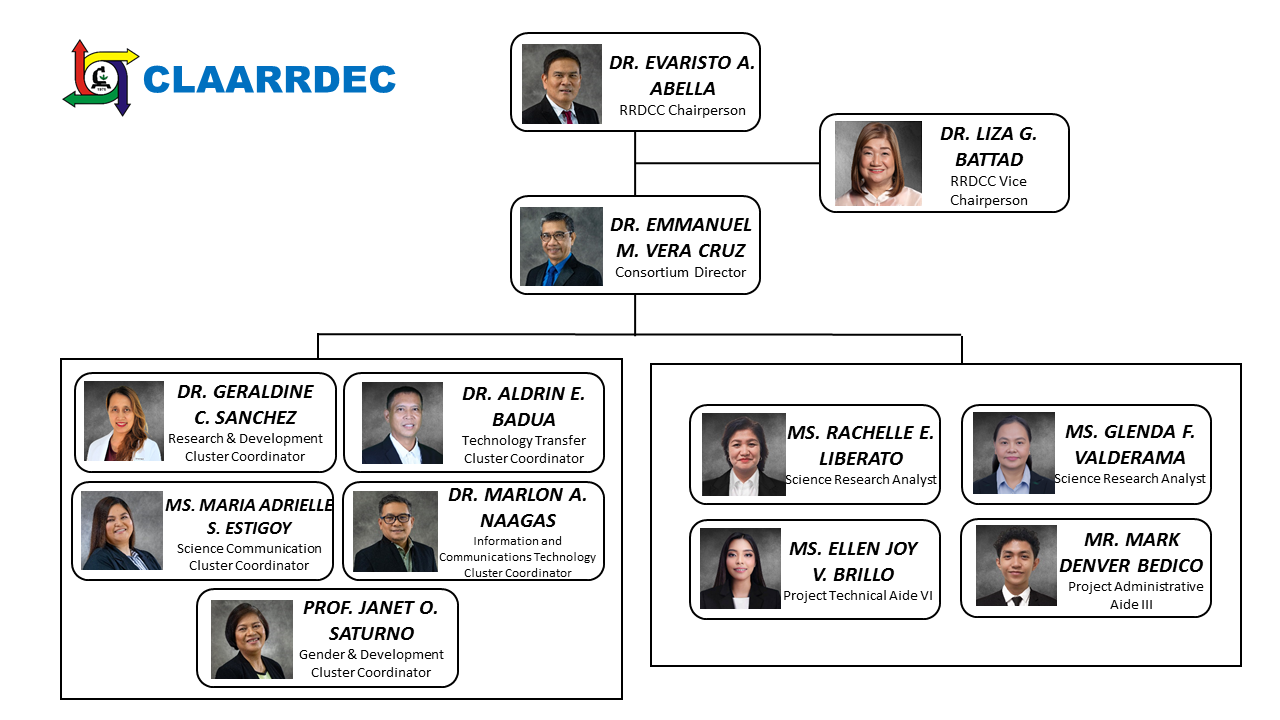 | Central Luzon Agriculture, Aquatic and Natural Resources Research and Development Consortium (CLAARRDEC) |
Establishment and Membership
It may be recalled that the Department of Science and Technology (DOST) established the Philippine Council for Agricultural Research (PCAR) in November 1972. Its creation brought hope for the agriculture, forestry and fisheries sectors of the country.
Four years after the creation of PCAR, the CLARC was born. It was the first of the several projects conceptualized by the team headed by Dr. Joseph Madamba. The CLARC aimed to place the operations of the experiment stations of the four pioneering member agencies under the umbrella of a coordinative management system without losing their own identity as they undertake research in crops, fisheries, soil, water and socio-economics. The pioneer member agencies include:
- Central Luzon State University (CLSU)
- Maligaya Rice Research and Training Center-Bureau of Plant Industry (MRRTC-BPI)
- Forest Research Institute (FORI)
- National Irrigation Administration-Upper Pampanga River Integrated Irrigation System (NIA-UPRIIS)
Organization wise, the CLARC was composed of the Research Complex Coordinating Committee (RCCC) and the Central Luzon Agricultural Research Complex Directorate. The former was created to serve as a policy making body while the latter was composed of Field Research Director and Assistant Field Research Director who administered the complex in accordance with the policies promulgated by the RCCC.
The scope of research responsibilities of the Complex were as follows: MRRTC-BPI: rice, vegetable crops (some); CLSU: cotton nd othr annual fiber crops, swine, water resources, inland fisheries, applied rural sociology, macro-economics; FORI: forage, pasture, watershed and range resources, wildlife; and NIA: land and water resources.
Training was an integral function of the Complex and the necessary training personnel ang facilities were provided under the general supervision of the Field Research Director.
Also, trainings on preparation research proposal, research methodologies and data analysis were conducted to enhance the knowledge and skills of the researchers/scientists. Eventually, trainings and technology generation, verification, packaging and dissemination were also undertaken.
As PCAR went through processes of change in its organization , scope, and functions the same was true for CLARC. PCAR as we all know became PCARR in 1975 as its realm included researches on natural resources. In 1987, it eventually became PCARRD to reflect its development orientation, Since then , PCARRD has been one of the R & D Councils of National Science and Technology Authority now Department of Science and Technology.
CLARC on the other hand also changed through the years. The acronym CLARC was maintained even as the letter C which stood for Complex was changed to Consortium in 1978. However, with the inclusion of natural resources and development concerns in its mandate, it eventually became the Central Luzon Agriculture and Resources Research and Development Consortium or CLARRDEC.
With the issuance of the Executive Order 366 by President Aquino on Oct. 4, 2011. The Philippine Council for Agriculture, Aquatic and Natural Resources Research and Development (PCAARRD) has been formed out of the merger of the Philippine Council for Agriculture, Forestry and Natural Resources Research and Development (PCARRD) and Philippine Council for Aquatic and Marine Research and Development (PCAMRD). Both councils were under the Department of Science and Technology (DOST). It aims to effect more efficiency in the delivery of R&D services in the agriculture, aquatic, and natural resources (AANR) sector, thus, evolution from CLARRDEC to CLAARRDEC by virtue of the merge of PCARRD and PCAMRD.
Vision
CLAARRDEC as the premier consortium for sustainable agriculture, aquatic and natural resources development through excellence in R and D.
Mission
To promote generation and commercialization of technologies on agriculture, fisheries and natural resources for sustainable regional development and global competitiveness.
Based on this premise, CLARRDEC’s goal is to effectively utilize research results in attaining sustainable development in agriculture, fisheries, environment and natural resources. It specifically aims to institutionalize and promote Regional R & D Programs that will hasten technology promotion and commercialization in the countryside.

































